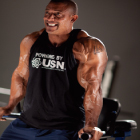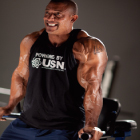

Q: My training partner says that the parallel-bar dip has done far more for building his terrific pecs than the bench press. I tried dips, but all I get is irritated shoulders. What am I doing wrong?
 A: It may be that your training partner is more suited to the parallel-bar dip than you are, or his exercise technique is better than yours, or his method of poundage progression is better than yours, or his attention to satisfying the components of recuperation from training is better than yours. There may be a genetic component too, but most likely it’s a combination of some or all of the above.
A: It may be that your training partner is more suited to the parallel-bar dip than you are, or his exercise technique is better than yours, or his method of poundage progression is better than yours, or his attention to satisfying the components of recuperation from training is better than yours. There may be a genetic component too, but most likely it’s a combination of some or all of the above.
Different people are more suited to certain exercises than others. Lanky individuals invariably struggle to make good progress on the bench press because their leverages are so different from those of short, barrel-chested, short-limbed people. Many people who struggle to make good progress on the bench press have found that the parallel-bar dip is a much more effective exercise for them—provided they use correct exercise technique, avoid overtraining, get excellent recuperation and add poundage gradually.
The parallel-bar dip doesn’t just work the pecs and the triceps; it also works the deltoids and the lats. The irritated shoulders indicate that your exercise technique is incorrect. Unless your shoulders are already injured, no exercise should irritate them if you do it correctly.
If you already have irritated shoulders, you shouldn’t be doing any exercise that works them. Wait until they are healthy. To get them healthy again, you may need more than rest alone—such as attention from a therapist. Many bodybuilders and nonbodybuilders apply the “just rest” strategy to recovering from an injury but often find it wanting. A few treatment sessions from an expert therapist can sometimes produce more benefit than years of avoiding activities that would otherwise irritate the problem.
Here are the most common errors to avoid if you’re to do parallel-bar dips safely and effectively:
Error 1: Wrong grip. Avoid a very wide grip or one in which your hands are pronated so that the knuckles are on the inside of the bars. Instead, use a medium-width grip—about 22 inches is good for most men—and a regular hand position. Try using V-shaped bars, if possible, to find the optimum hand spacing for you. Face the part of the unit where the V comes together, not where the rails fan out.
Error 2: Excessive range of motion. An exaggerated range of motion, which includes stretching at the bottom of each rep, has injured countless bodybuilders. Instead, use a comfortable range of motion, and never exaggerate it. For most bodybuilders the maximum safe depth on a parallel-bar dip is where the upper arm is parallel to the floor or just slightly below that point.
Error 3: Wrong breathing. Never descend on a deflated chest. Inhale before you descend, and then exhale during the ascent. Going into the bottom position of the dip on a deflated chest increases the risk of injury, so keep your chest full during the descent and the early part of the ascent.
Error 4: Swinging legs. Don’t let your lower limbs swing as you dip, and neither thrust your head forward nor throw it back. Furthermore, keep your chest stuck out to help keep your shoulders pulled back and safe.
Error 5: Wrong elbow positioning. If you force your elbows into an unnatural plane during the dip, you risk hurting yourself. Keep your elbows in the same plane as your wrists or slightly to the outside of that plane.
Error 6: Fast rep speed. Take at least two seconds to descend on each dip. Pause for a second at the bottom, and then push up in a controlled, smooth manner—taking about two seconds for each ascent. Never relax at the bottom; stay tight. Take a pause for a second or two between reps at the top position, but don’t let your shoulders slump as you hold yourself on locked elbows. Keep your head and shoulders up high, and stay tight.
Error 7: Inadequate warm up. To warm up for the dip, start with floor pushups. Then, from the upright position of the dip, perform partial reps as you gradually work into your bottom position. After that you should be ready for a work set or, if you use a large weight for your work sets, for another warmup set with additional weight.
Error 8: Adding poundage too quickly. Strength permitting, add weight slowly and in small increments, using a dipping belt. To work from one fixed-weight dumbbell to the next, attach a small disk weight in addition to the dumbbell or use an adjustable dumbbell. Alternatively, use individual weight plates with a belt fitted through them. Regardless of how you attach the poundage, make your weight increments no more than one pound at a time, and only add weight when you’ve really mastered your current best poundage.
Finally, if you still can’t get the freestyle parallel-bar dip to work for you after applying all that I’ve already recommended, try a dip machine. With a machine a slight change in torso or wrist position can produce significant improvement in comfort, and the range of movement can be easily controlled. In addition, because you start with little or no resistance, the machine unit can be used by bodybuilders who don’t yet have the strength to do conventional parallel-bar dips.
—Stuart McRobert
www.Hardgainer.com
Editor’s note: Stuart McRobert’s first byline in IRON MAN appeared in 1981. He’s the author of the new BRAWN series, Book 1: How to Build Up to 50 Pounds of Muscle the Natural Way, available from Home Gym Warehouse (800) 447-0008 or www
.Home-Gym.com.




















You must be logged in to post a comment Login